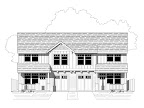You've just bought 200 rolls of pink insulation at your local big box hardware store. You look at the bag and see R-21. You're in a crunch so you jam the insulation into the walls, give it a quick once-over and have your inspection. Your inspector approves so you jam on and get the sheetrock installed. The question is, what is the R-value of your wall? R-21? Think again.
R-21 refers to the insulative factor of the fiberglass. This fiberglass only exists between your studs and plates. Standard framing of 16" o.c. with full headers results in up to 25% of the face of your building being wood alone. "Okay", you say, "So 75% of my wall is insulated, right?". Well don't forget about your windows and doors. Those can account for up to 15% of your walls. So only 60% of your walls is actually pink fiberglass. Then we must consider how well you installed. First of all, did you staple the kraft paper to the edge of the studs, or just inside the opening? "I stapled it inside, otherwise it interferes with the sheetrock." How about gaps between pieces of insulation or within cavities. "Just a little bit here and there, definitely not more than 3% of the wall." How did you handle wiring and plumbing or electrical boxes? "Um, shoved it in behind... why do you ask?"
Thanks for your curiosity. Let's do a little bit of math to answer your question. First off we must understand what a U-value is. It is simply the mathematical inverse of R-value, that is: U=1/R. If you pull out your calculator, you'll see that the U-value of R-21 insulation is about 0.05. For your reference, wood has an R-value of about 1.25 per inch so a 5.5" stud will have and R-value of 6.88 and a U-value of 0.15. Your windows are probably U=0.40 (which equates to R-2.5). To figure out the R-value of your entire wall, multiply the percentage of a given area by it's U-value, then add all the figures together and finally take the mathematical inverse. In this case, our equation would be:
1 / ((60% x 0.05) + (25% x 0.15) + (15% x 0.40)). This is your insulation, wood, and windows.
1 / (0.03 + .0375 + 0.06) = 1 / 0.1275 = R-7.84.
"7.84? Are you sure that's right?". Well, we rounded for convenience but it's close. Without rounding we get R-8. Oh wait, we didn't consider that you left a 3% gap in your insulation job. That little 3% void area reduces your insulation value from R-21 to R-11. Oops. So recalculating with a U-value of 0.067 instead of 0.05 drops your (unrounded) R-value of that wall down to 6.62. Not good.
"Well I gave it my best shot, that's the way it is. Besides that's how most builders do it."
You're right, that is how most builders do it. Way to blend into the crowd and not differentiate yourself. There's a green wave of consumer awareness breaking and anyone not on board will get washed away.
If you're interested in how to fix this, read on.
First problem is the framing. You really should be spacing your studs at 24" o.c., using two stud or modified three stud corners, and only putting headers where necessary. These steps can reduce your lumber from 25% of a wall to 15%. That's a 40% reduction in your lumber bill. Still think building green is more expensive?
Second problem is the pink insulation. It can never be perfectly installed (although it can get close). A better alternative is blown-in batts (AKA BIBS), spray cellulose, or spray foam. Yes spray foam is expensive but the BIBS system is comparable in cost, fills all the voids, and offers better insulation overall (R-23 vs. R-21).
Third problem is the windows. Quite frankly a U-value of 0.40 is not that great. Better to use U-0.32 or less.
Given these three factors your new equation will be:
1 / ((70% x 0.05) + (15% x 0.15) + (15% x 0.32)) =
1 / (0.03 + 0.02 + 0.05) = R-10
Better, but you'll notice it's still not R-21. That's the whole point. We want to let you know that despite all your best efforts, a 2x6 wall will still only reach half of what is perceived as it's potential value. If you really want good walls, consider sheathing the outside of the framing with rigid foam insulation, building a double wall, or using SIPS. Some SIPS manufacturer's claim comparable R-values of 50, though this is in comparison to the perceived R-21 value of walls. Still this results in a true R-value of R-20 or more compared to your stick frame wall of R-10.
Caveat Emptor.
Tuesday, September 23, 2008
Subscribe to:
Post Comments (Atom)






No comments:
Post a Comment